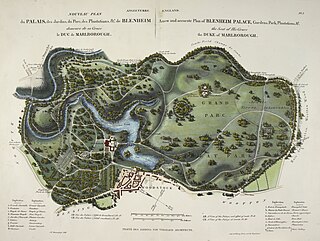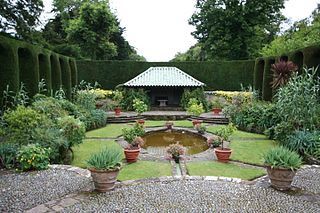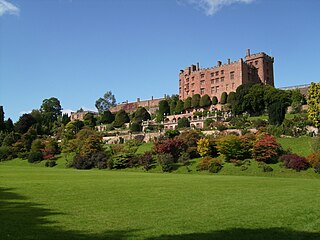The Register of Historic Parks and Gardens of Special Historic Interest in England provides a listing and classification system for historic parks and gardens similar to that used for listed buildings. The register was set up by Historic England under the provisions of the National Heritage Act 1983. [1] Over 1,600 sites are listed, ranging from the grounds of large stately homes to small domestic gardens, as well other designed landscapes such as town squares, public parks and cemeteries. [2] The register is published on the National Heritage List for England alongside other national heritage designations. [3]
The register aims to "celebrate designed landscapes of note, and encourage appropriate protection", [2] so safeguarding the features and qualities of key landscapes for the future. It is hoped that listing sites of special interest will increase awareness of their value and encourage those who own them, or who have a part to play in their protection, to treat the sites with due care, whether this is a question of carrying out appropriate maintenance or making changes to the site.
If a park or garden has been registered using the designation process under the National Heritage Act 1983 it has legal protection. [4] Registration is a material consideration in the planning process so, following a planning application for development which would affect a registered park or garden, local planning authorities must take into account the historic interest of the site when deciding whether or not to grant permission for any changes. [5] Although the inclusion brings no additional statutory controls in itself, English local authorities are required by government to take the protection of the historic environment into account in their policies and resource allocations. If material changes are made to a registered park or garden without having been granted planning permission first, local planning authorities may require that the changes are undone and, in extreme cases, a prosecution may result. [6]
The register is also used in influencing management decisions, to improve public awareness of important parks and elements within them and to encourage their owners to preserve and maintain them. Gardening and landscape design have long been important preoccupations to the British and, although a wealth of historic parks and gardens exist, they are a fragile and finite resource: they can easily be damaged beyond repair or lost forever.
Since 1995, the Garden History Society has been a statutory consultee in relation to planning proposals which affect historic designed landscapes identified by Historic England as being of national significance and which are included on the Register of Parks and Gardens of Special Historic Interest in England. This means that when a planning authority receives a planning application which affects a site on the Register, or the setting of such a site, the planning authority must consult the Garden History Society. This applies to registered sites of all grades. In addition, Historic England must be consulted where a planning proposal affects a site which is included on the Register at Grade I or Grade II*. [7]
An online searchable register of all registered parks and gardens that are legally protected through the designation system, has been incorporated into the National Heritage List for England currently available through the Historic England website. [8] This shows the relevant list entry which describes the park or garden, and shows where it is on a map. [9] Not all designated parks and gardens are open to the public. Information on historic parks and gardens can also be searched online via Parks & Gardens UK (a partnership between the Association of Gardens Trusts and the University of York). This site does not claim to have any statutory authority and includes a wider range of sites across the UK. [10]
Eligibility for the register is based around documentary research and field survey which attempts to classify and date each park according to set criteria. These are:
As with listed buildings, parks and gardens are graded on a scale, Grade I being internationally significant sites are therefore the most important and constitute around 10% of the total number. Historically important gardens are Grade II* (about 30% of the total) and the remainder are of regional or national importance and are Grade II registered.
Separate registers of parks, gardens and designed landscapes are maintained in the other countries of the United Kingdom:

In the United Kingdom, a scheduled monument is a nationally important archaeological site or historic building, given protection against unauthorised change.

Cadw is the historic environment service of the Welsh Government and part of the Tourism and Culture group. Cadw works to protect the historic buildings and structures, the landscapes and heritage sites of Wales, to make them available for the public to visit, enjoy, and understand their significance. Cadw manages 127 state-owned properties and sites. It arranges events at its managed properties, provides lectures and teaching sessions, offers heritage walks, and hosts an online shop. Members of the public can become members of Cadw to gain membership privileges.

In the United Kingdom, a listed building is a structure of particular architectural and/or historic interest deserving of special protection. Such buildings are placed on one of the four statutory lists maintained by Historic England in England, Historic Environment Scotland in Scotland, Cadw in Wales, and the Northern Ireland Environment Agency in Northern Ireland. The classification schemes differ between England and Wales, Scotland, and Northern Ireland. The term has also been used in the Republic of Ireland, where buildings are protected under the Planning and Development Act 2000, although the statutory term in Ireland is "protected structure."
There are over 2500 listed buildings in Liverpool, England. A listed building is one considered to be of special architectural, historical or cultural significance, which is protected from being demolished, extended or altered, unless special permission is granted by the relevant planning authorities.

Historic garden conservation is a specialised type of historic preservation and conservation or restoration concerned with historical and landmark gardens and designed landscapes.
Penllergare is a country park in Wales. It was the estate of John Dillwyn Llewelyn adjacent to what is now the village of Penllergaer, Swansea. Although the names are similar, the village of Penllergaer grew up as a separate entity from the Penllergare estate. The park is listed on the Cadw/ICOMOS Register of Parks and Gardens of Special Historic Interest in Wales.
Historic England is an executive non-departmental public body of the British Government sponsored by the Department for Culture, Media and Sport. It is tasked with protecting the historic environment of England by preserving and listing historic buildings, scheduling ancient monuments, registering historic parks and gardens, advising central and local government, and promoting the public's enjoyment of, and advancing their knowledge of, ancient monuments and historic buildings.
An annual Heritage at Risk Register is published by Historic England. The survey is used by national and local government, a wide range of individuals and heritage groups to establish the extent of risk and to help assess priorities for action and funding decisions. This heritage-at-risk data is one of the UK government's official statistics.

Brandwood End Cemetery is a cemetery located in the Brandwood ward of Birmingham, England.

The Inventory of Gardens and Designed Landscapes in Scotland is a listing of gardens and designed landscapes of national artistic and/or historical significance, in Scotland. The Inventory was originally compiled in 1987, although it is a continually evolving list. From 1991 it was maintained by Historic Scotland and Scottish Natural Heritage, and is now updated by a dedicated team within Historic Environment Scotland. As of 2016 the Inventory includes over 300 sites across Scotland.
Registered battlefields in the UK are battlefields recognised as having specific historic or cultural significance. They are recognised as such by conservationist organisations for a variety of reasons, including protecting them from development that may threaten historic buildings, items, or topography. The history relating to them is often hard to unravel, as there is often little to see above ground and the historical record is often biased in favour of the victors. The UK has many historic battlefield sites, some of which have legal protection through heritage protection legislation whilst others are protected through landscape legislation. More recently, some archaeologists prefer the term "site of conflict" to "battlefield", because of the difficulty in defining the geographical extent of a site.

The Register of Parks, Gardens and Demesnes of Special Historic Interest is a listing of significant ornamental parks and gardens in Northern Ireland. It is maintained by the Northern Ireland Environment Agency (NIEA), an executive agency within the Department of the Environment of the Northern Ireland Executive.

The Cadw/ICOMOS Register of Parks and Gardens of Special Historic Interest in Wales is a heritage register of significant historic parks and gardens in Wales. It is maintained by Cadw, the historic environment service of the Welsh Government and was given statutory status in 2022.

The Gardens Trust is a national membership organisation in the United Kingdom established to study the history of gardening and to protect historic gardens.

Mounton House, Mounton, Monmouthshire, Wales, is the last major country house built in the county, constructed between 1910 and 1912 by the architect and writer Henry Avray Tipping for himself. Formerly a school, which has now relocated to the grounds, the house has been divided into apartments. It is a Grade II* listed building. The surrounding park is on the Cadw/ICOMOS Register of Parks and Gardens of Special Historic Interest in Wales.

Many parts of Scotland are protected in accordance with a number of national and international designations because of their environmental, historical or cultural value. Protected areas can be divided according to the type of resource which each seeks to protect. NatureScot has various roles in the delivery of many environmental designations in Scotland, i.e. those aimed at protecting flora and fauna, scenic qualities and geological features. Historic Environment Scotland is responsible for designations that protect sites of historic and cultural importance. Some international designations, such as World Heritage Sites, can cover both categories of site.

Merthyr Tydfil County Borough is located in the historic county of Glamorgan in Wales and takes its name from its largest town. The county borough covers an area of 111 km2 (43 sq mi) and had a population of approximately 58,900 in 2021. There are three sites on the register of parks and gardens in Merthyr Tydfil County Borough. Two are listed at Grade II*, and one is Grade II.

Monmouthshire is a county of Wales. It borders Torfaen and Newport to the west; Herefordshire and Gloucestershire to the east; and Powys to the north. The largest town is Abergavenny, with other large settlements being Chepstow, Monmouth, and Usk. The present county was formed under the Local Government (Wales) Act 1994, which came into effect in 1996. It has an area of 850 km2 (330 sq mi), with a population of 93,200 as of 2021. Monmouthshire comprises some sixty per cent of the historic county, and was known as Gwent between 1974 and 1996.
The Register of Landscapes of Historic Interest in Wales is a non-statutory heritage register of 58 landscapes of outstanding or special historic interest published in two volumes. It was produced by a partnership between Cadw, the Countryside Council for Wales, and the International Council on Monuments and Sites working in collaboration with the Welsh Archaeological Trusts and several other organisations with the intention of aiding in the protection and conservation of the most important and significant historic landscape areas in Wales.

The City and County of Cardiff is a county in the south of Wales. It covers an area of 140.3 km2 (54.2 sq mi) and in 2023 the population was approximately 359,512. Cardiff is the country's capital and hosts its parliament, the Senedd, and a large number of national institutions such as the Wales Millennium Centre, the National Museum, the national stadium of Wales and the St Fagans National Museum of History.